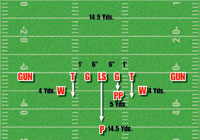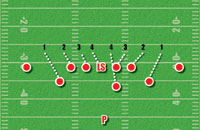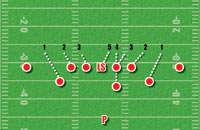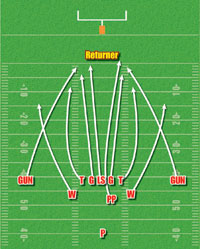AMERICAN FOOTBALL MONTHLY THE #1 RESOURCE FOR FOOTBALL COACHES
Article CategoriesAFM Magazine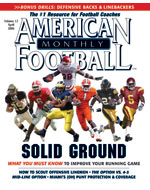
|
Deep Impact: Redhawk Punt Team: Protection and Coverageby: Rusty Wright© More from this issue We always hear in football that no other play has a bigger impact on the game than the punt. We all know that it is true, so to be effective in this phase you must make your scheme simple and sound. Here at Miami University we feel that we have achieved this with our scheme of punt protection. There are three basic principles we follow as a punt team. 1st, we must have a constant split by our personnel. We cannot get forced wide or down inside. 2nd, our sets are vertical, not diagonal. We must get depth off of the ball. 3rd, we must stay square. We must create the same LOS 3 1/2 yards deep. Stance and Alignment (See Diagram 1)
Long Snapper - Comfortable stance that will allow you to deliver a great snap and become a part of the protection. Guards/Tackle and Wings - Two-point stance with feet shoulder width apart. Flat back with a big chest and bend at the waist. Hands on knees with the eyes having big vision. Inside foot should be up, outside foot back with a heel to toe stagger. Your weight should be on the up foot ready to push off at the snap of the ball. The guards will take six inch splits from the snapper with their inside foot on the heel of the snapper’s foot. The guard’s helmet must break the plane of the LS hip. Take as much as you can! The tackles have a one foot split from the guard’s outside foot. They align on the inside foot of the guard. The wings will draw an imaginary line from the tackles outside foot to a point four yards deep and place their inside foot on it. Set your stance at a 45 degree angle to the rest of the line. Personal protector - In a two-point stance with feet parallel. Flat back with a big chest and bend at the waist. Eyes up, hands resting on thigh-boards. His alignment is directly behind the guard five yards deep. He must set the integrity of the pocket. Gunners - They are in a two-point stance with inside foot forward and outside foot staggered for great take-off. With the ball in the MOF, align outside the numbers on the LOS. With the ball on a hash, gunner into the boundary must align wide enough to eliminate the threat of a player covering him moving inside and coming off the corner. Gunners must put the cover player wide in space. Punter - Is in a two-point stance with a slight bend ready to accept the snap. His alignment is 14 1/2 yards deep from the LOS. Cadence The personal protector is our “quarterback” on this team. He will handle all of the cadence information during the execution of the punting game. The information in the cadence may vary week to week depending on the game plan. The cadence will help us identify the front and set the protection accordingly. • The first call will determine the number of rushers (6/7 or 8). • The second will identify the front (balanced or overload). • The third call will set the protection (right or left). • The fourth call will tell the long snapper when the ball is ready to be snapped. Protection The protection we use at Miami is based on zone principles but with a man scheme. Each man is responsible for a rusher but, we will always take our drops to create a solid pocket. We NEVER chase. We will always block “who becomes” our rusher if we are faced with twists or crossers. • Each side of the punt team’s responsibility starts from the outside in. The wings have #1, the tackles have #2, the guards have #3, the center has #4 to the call side and the PP takes #4 away fro the call side. • The zone scheme puts us in position to block any twists and stems that may occur. This will allow us to realize “who becomes” our rusher. It will also create the cup of the pocket. • Keeping the constant split is important. Each man must set with vertical depth off of the LOS and keep a constant split. If everyone sets vertically, it maintains the integrity of the pocket and reduces the rush lanes. • Keep the shoulders square and create the constant wall. Let all threats come to you. We NEVER chase! • At the snap of the ball push off the LOS using the inside foot as the drive point. Jab hard with your inside hand as you gain depth kick sliding with your outside foot like an offensive lineman would do. Your inside hand is for help, your outside hand is to block your man. a. 1 hand kick slide b. 1 hand kick slide c. 2 hands block my man We take the three kick slide steps to sort out anything that may be different than a straight rush. You must remember that the rush team must go through us to block the kick and that is why we never chase. Even though each person is responsible for a rusher we do not point out or identify them individually because when the ball is snapped they all could change. We do what we do and let them come to us. (See Diagrams 2, 3, and 4). Coverage
Punt coverage requires soundness, attitude and hitting. Our coverage philosophy is that we will pressure the punt returner with our gunners going down the field and taking “a shot”; containing the ball with our wings; and then squeezing the ball down in this area with our long snapper, personal protector, guards and tackles (See Diagram 5). Coverage Stages • PROTECT! PROTECT and PROTECT! • Fight through any hold up, try and work an outside release and get on top of the defender. • Run through assigned coverage landmark. • Do not follow the same colored jersey down the field. Keep a four yard relationship with the man inside of you. • Find the punt returner; he is where the ball is going to be. • Use a landmark of seven yards in front of the punt returner as the alert to gather your feet, break-down and be ready to make the tackle. • Squeeze the returner by always keeping him on your inside shoulder. Shuffle with him coming to you, close when he is away.
Coverage Assignments: Ball being kicked in MOF Gunners - Take a shot at a ‘solo’ tackle. Worst case scenario make the returner bounce the ball laterally. Long snapper and Personal Protector - Left and right shoulder of the returner. Guards - Uprights of the goal post. Tackles - One yard outside the hash. Wings - In between the hash and the #’s. I hope this will help you and your teams performance in the kicking game. If you have any questions or concerns please feel free to contact us at Miami University. |
|
| HOME |
MAGAZINE |
SUBSCRIBE | ONLINE COLUMNISTS | COACHING VIDEOS |
Copyright 2025, AmericanFootballMonthly.com
All Rights Reserved


